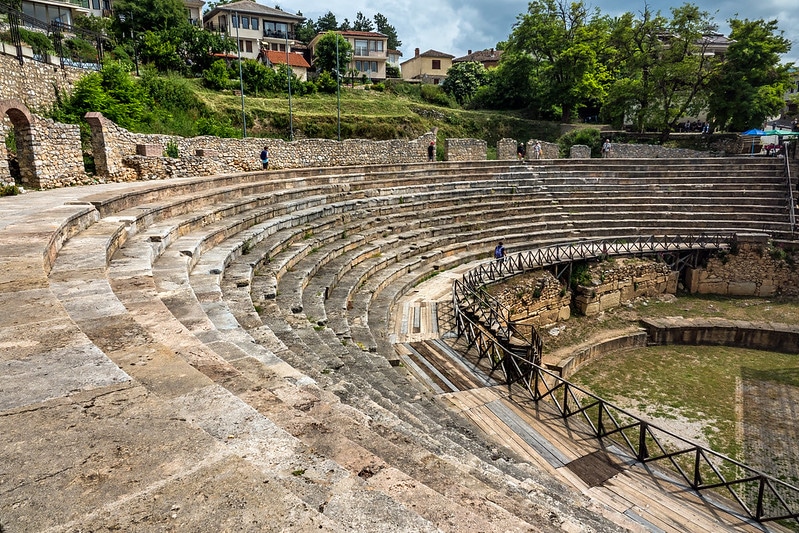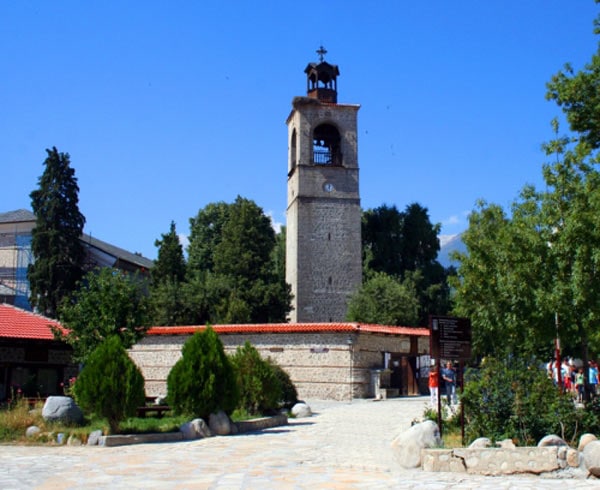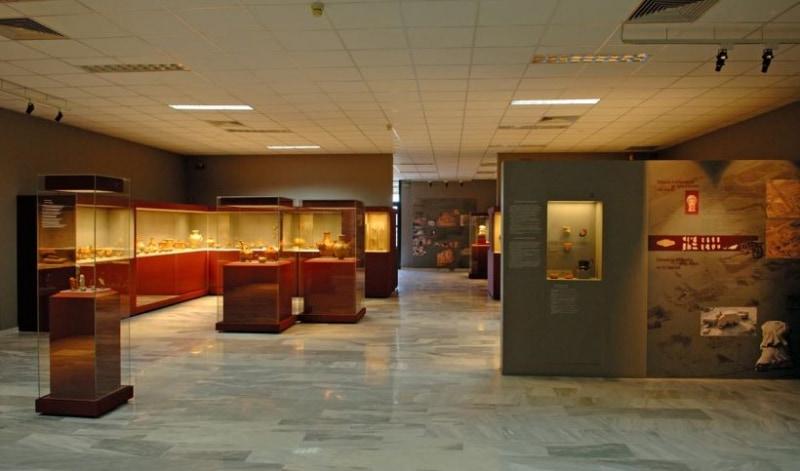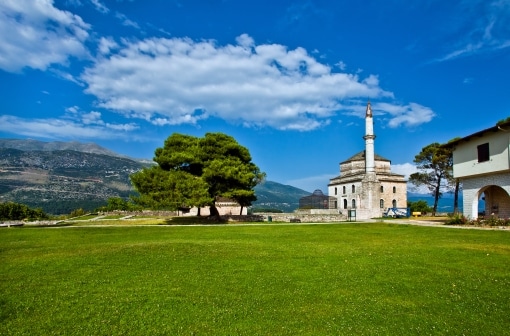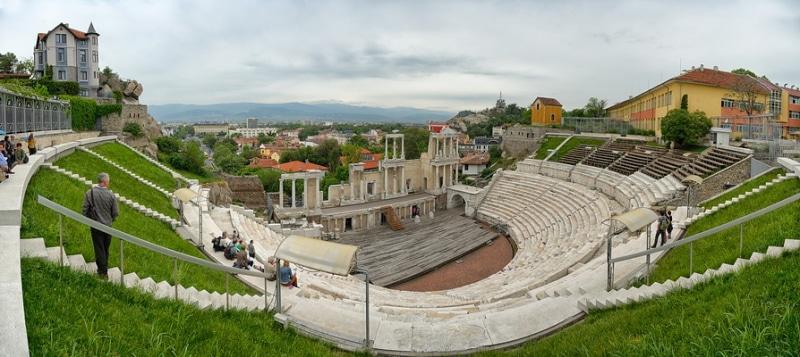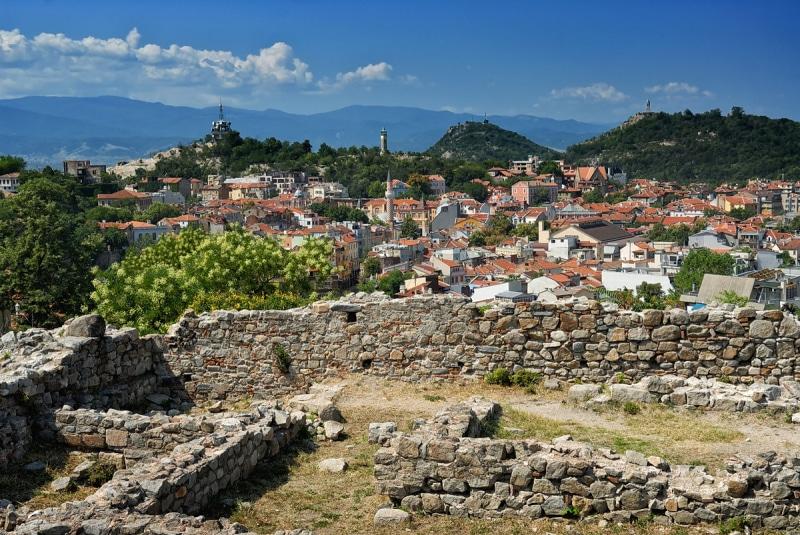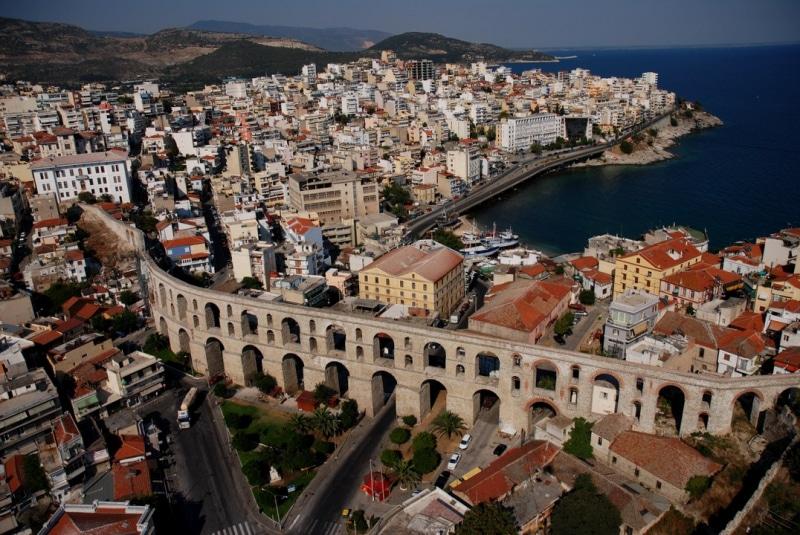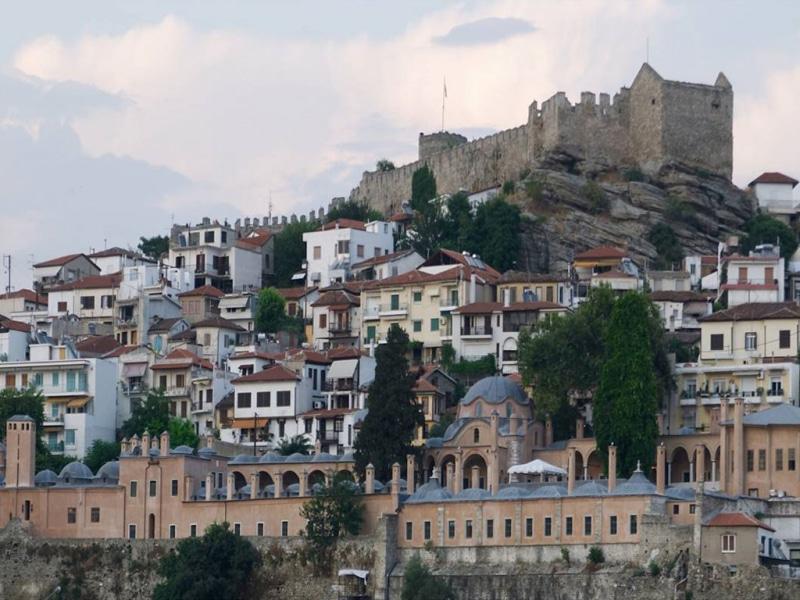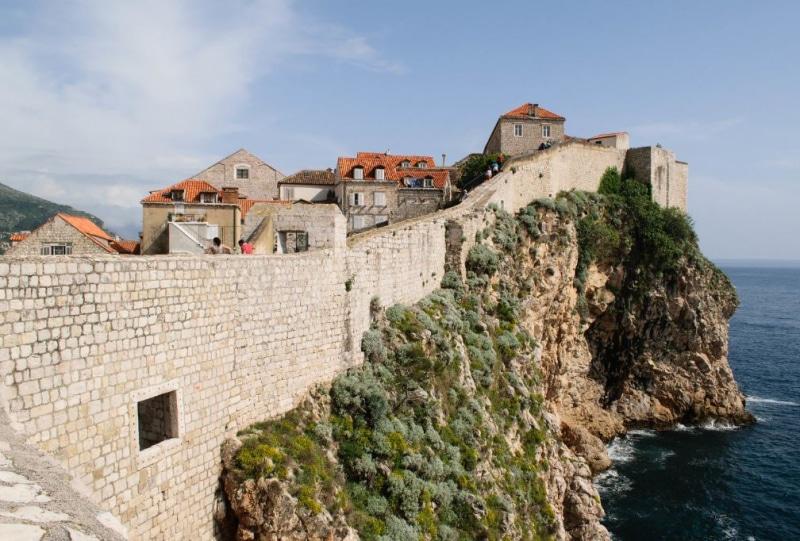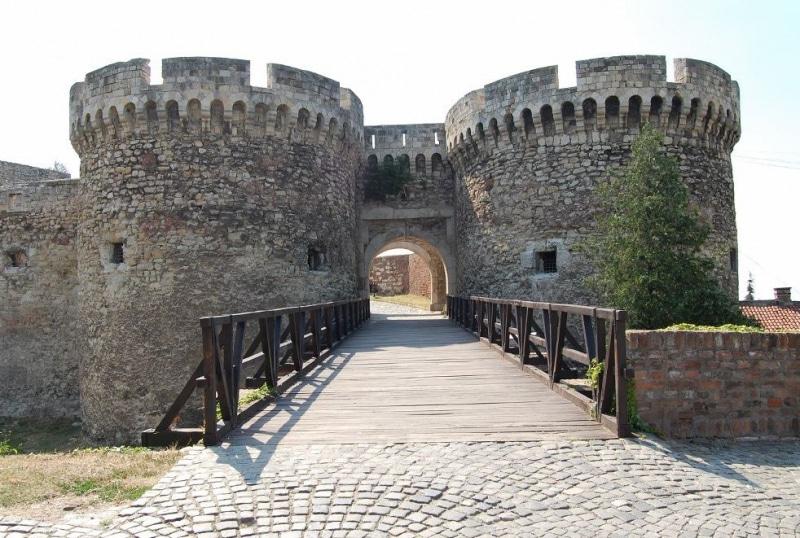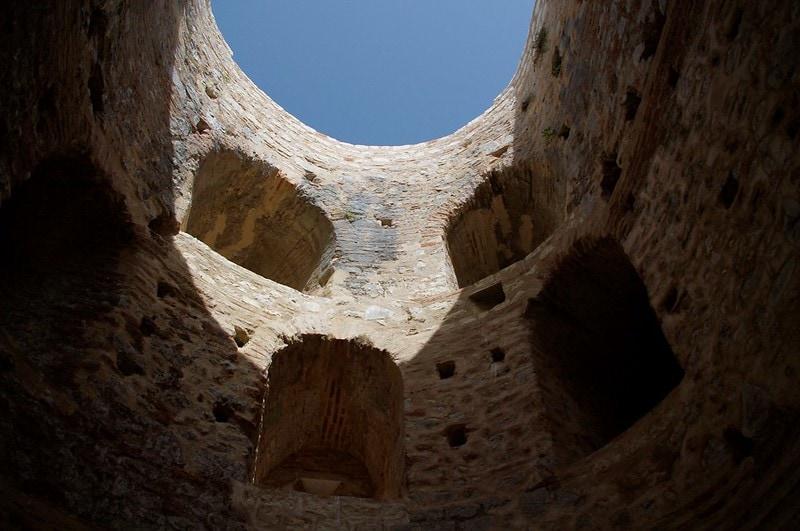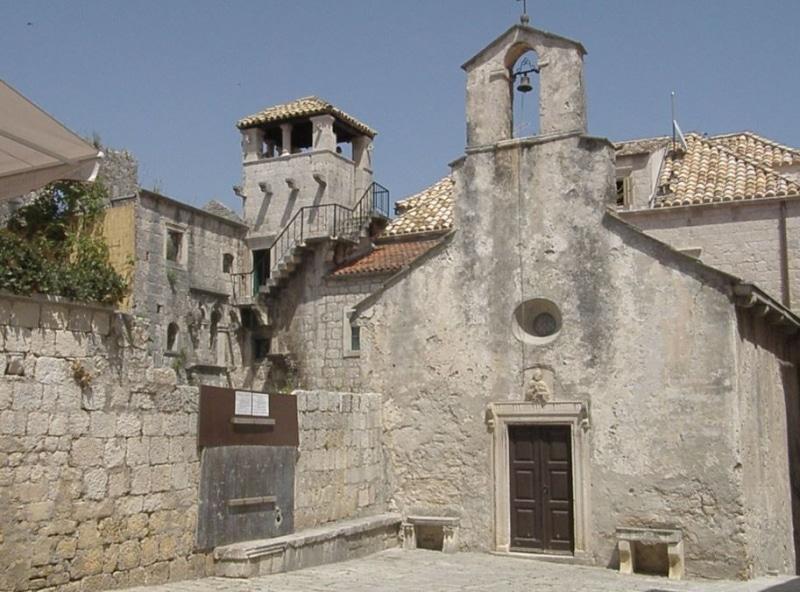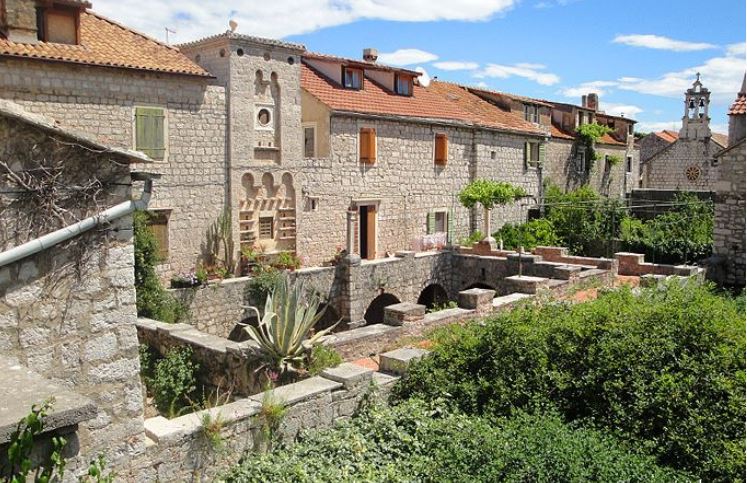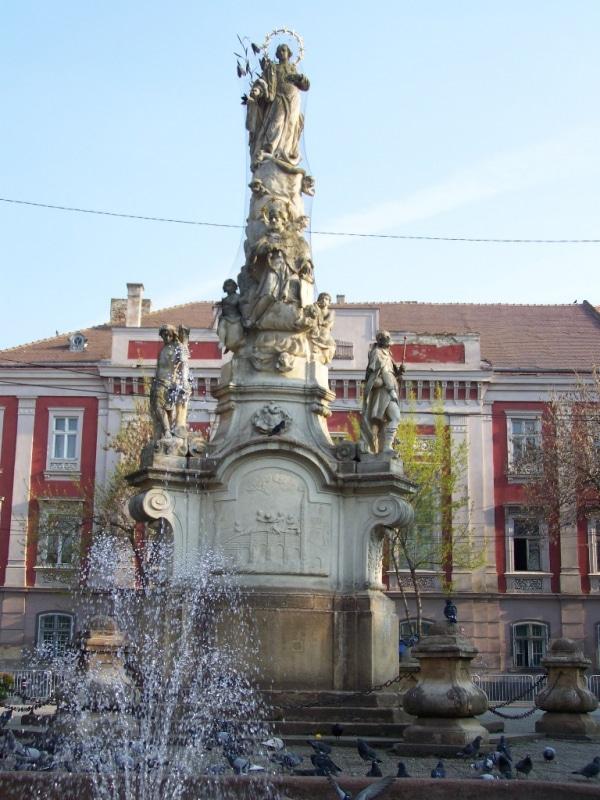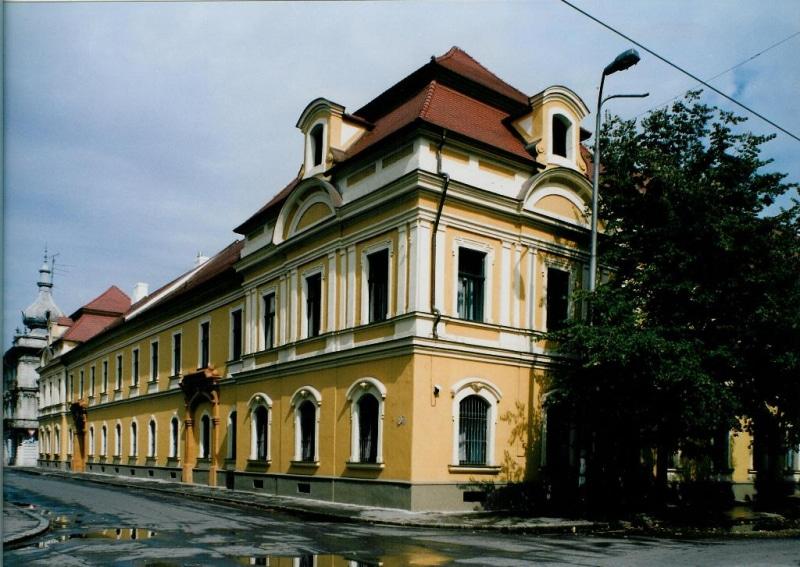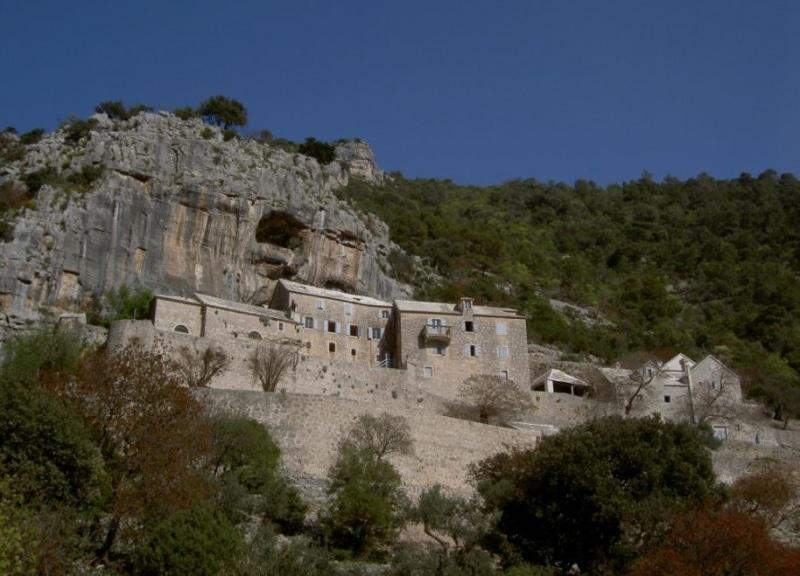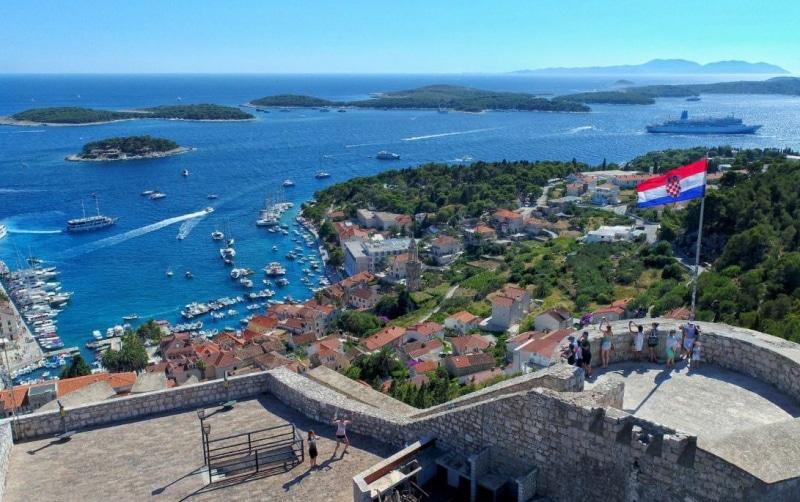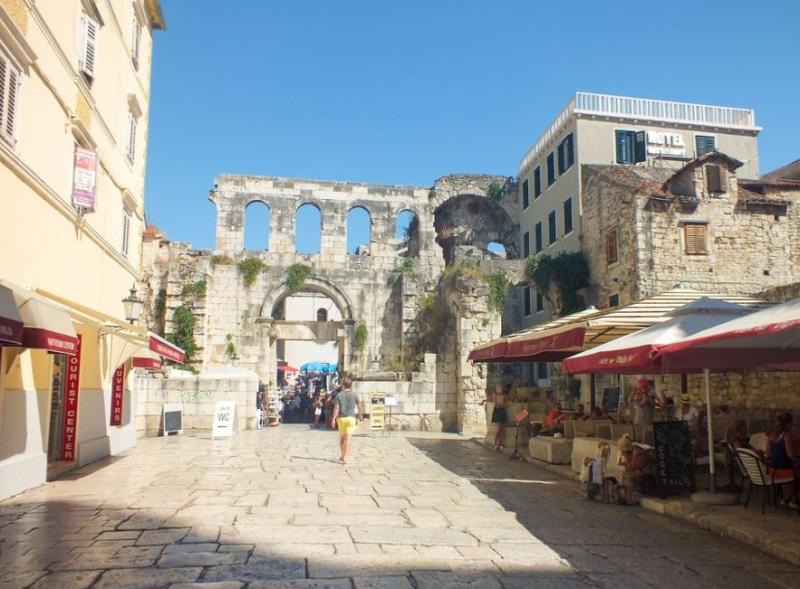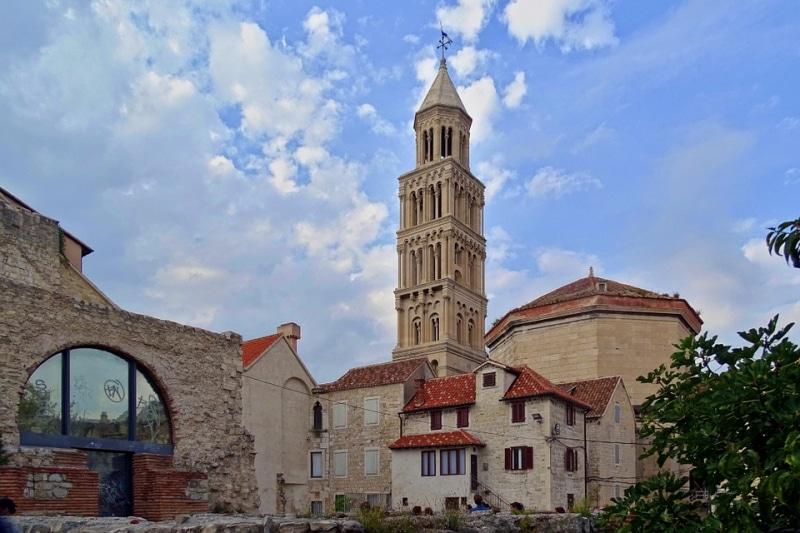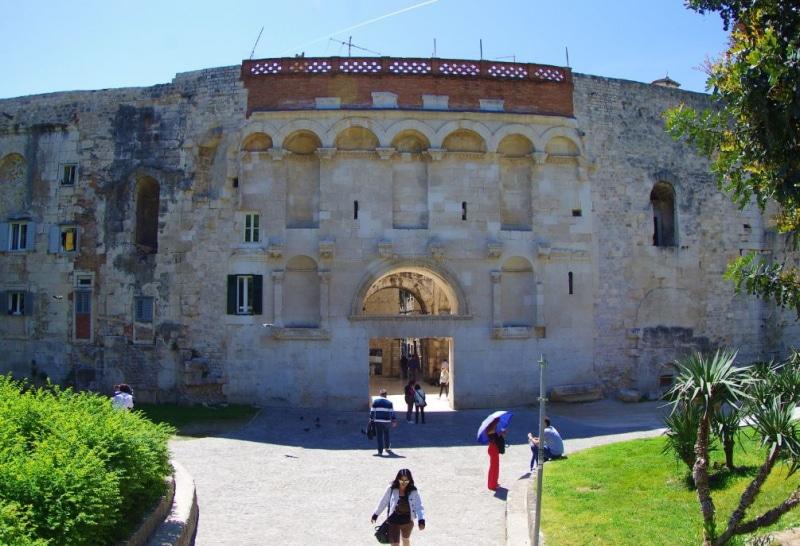HistoricalSites, Skopje
Removed from Unnamed collection
Fortress Kale
The Skopje Fortress commonly referred to as Kale Fortress, or simply Kale (from kale, the Turkish word for 'fortress'), is a historic fortress located in Skopje, the capital of the Republic of Macedonia. It is situated on the highest point in the city overlooking the Vardar River. The fortress is depicted on the coat of arms of Skopje, which in turn is incorporated in the city's flag.
The first fortress, according to research and available data, is believed to have been built amidst the 6th century A.D., on land that had been inhabited during the Neolithic and Bronze ages or roughly 4000 B.C. It was constructed with yellow limestone and travertine and along with fragments of Latin inscriptions, asserts the idea that the fortress originated from the Roman city of Skupi, which was completely destroyed by an earthquake in 518.
The fortress is thought to have been reconstructed during the rule of emperor Justinian I and constructed further during the 10th and 11th centuries over the remains of emperor Justinian's Byzantine fortress which may have been destroyed due to a number of wars and battles in the region, such as that of the uprising of the Bulgarian Empire against the Byzantine Empire under the rule of Peter Delyan. Not much is known about the Medieval fortress apart from a few documents which outline minor characteristics in the fortress' appearance. http://www.exploringmacedonia.com/fortress-kale.nspx
Map
Explore more places related to this search:
Removed from Unnamed collection
Ancient Theatre of Ohrid
The builders of Ohrid’s ancient theater have estimated very precisely where to put the building - in the center of the elevated old town. The open theater holds a perfect location, as the two hills (Gorni Saraj and Deboj) keep it protected from winds that could interfere with acoustics during performances. The Ancient theatre of Ohrid of the Hellenistic period was built in 200 BC and is the only Hellenistic-type theatre in the country as the other three in Scupi, Stobi and Heraclea Lyncestis are from Roman times. It is unclear how many people the original theatre used to seat, as only the lower section still exists.
During Roman times, the theater was also used for gladiator fights. However, since the theater was also a site of executions of Christians by the Romans, it rapidly turned to a highly disliked site by the locals. In fact, as a result of this dislike, the theatre was abandoned and buried by the locals after the demise of the Roman Empire. Discovered accidentally and later excavated completely, this 4, 000 square meter monument to antique Greco-Roman culture is being used today during the annual Ohrid Summer Festival for performances of ancient tragedies and comedies. The Theatre offers a wonderful view of Lake Ohrid and Mt. Galichica to the southeast. http://www.exploringmacedonia.com/ancient-theater.nspx
Map
Removed from Unnamed collection
The Pyramid
It is absolutely an important tourist attraction. As a symbol of a notorious communism, it resisted some attempts to be destroyed by previous governments. But it is still there, unrestored, a symbol of the mixed and contradictory history of Tirana. It was inaugurated on October 14, 1988, as the mausoleum of the dictator, Enver Hoxha. The pyramid form was designed by a group of architects led by the daughter and son-in-law of the dictator. Construction began in 1986 and ended in 1988. It did indeed serve as a mausoleum for Hoxha, until 1991, after which it became a conference and fair centre. http://www.visit-tirana.com/things-to-do/attractions/21/the-pyramid
Map
Removed from Unnamed collection
Macedonian Mension
You will absolutely fall in love with the byzantine churches and the beautiful mansions, which are typical examples of Macedonian architecture. http://www.visitgreece.gr/en/main_cities/kastoria
Map
Removed from Unnamed collection
Holy Trinity Church
The Holy Trinity Church and especially its tall belfry have become a symbol of Bansko as one of the most attractive mountain resorts, successfully combining the charm of its rich historical past and its picturesque location at the foot of the mighty Pirin Mountain with the most modern facilities for recreation – a wide choice of reputable hotels for all tastes and budgets, one of the best ski zone in South-East Europe.
The Church dedicated to the Holy Trinity was built in the period of the Bulgarian National Revival. Its inauguration was made in 1835. The architectural plan of the church is a three-nave basilica or more exactly a pseudo-basilica with 44 m length, 22 m width and 12 m height. The walls are 1.1 m thick and entirely constructed of local ashlar, welded together by mortar. Large wooden beams of centuries old white fir (typical for the region) are used in the foundation and for leveling the walls. Part of the church is sunken under the ground level in order to look smaller from the outside and Turks can not get an idea about its real size. The altar piece is set within a skillfully constructed and decorated apse in the form of the half of a 18-angle prism with a remarkable stone cornice on the exterior. The roof is hold in the interior of the church by 12 massive wooden columns of white fir, symbolizing the 12 apostles. http://bansko-guide.com/attraction/holy-trinity-church/
Map
Removed from Unnamed collection
White Tower
One of the historical Site in the city if Thessaloniki which form the center of city and has ancient Value attach to it. http://www.visitgreece.gr/en/main_cities/thessaloniki
Map
Removed from Unnamed collection
Archaeological site of Aiane
The ancient city of Aiane was the most important of the kingdom of Elimeia. From the finds here, archaeologists have concluded that it was home to quite an advanced civilisation, on a par with the Mycenaeans. http://www.discovergreece.com/en/mainland/macedonia/kozani
Map
Removed from Unnamed collection
The Castle of Ioannina
The imposing castle of Ioannina was built in 528 AD by the Emperor Justinian, and was an ambitious expression of the might of the Byzantine Empire. It is the oldest Byzantine fortress in Greece with significant influence over the history of the town which grew around it. http://www.visitgreece.gr/en/main_cities/ioannina
Map
Removed from Unnamed collection
Roman Stadium
The Stadium of Philippopolis was built in the beginning of 2nd century AD during the reign Emperor Hadrian. It is situated in the Northern part of the fortified city surrounded by defence walls, in the natural terrain between Taksim Tepe and Sahat Tepe.
The facility, approximately 240 meters long and 50 meters wide, could seat up to 30 000 spectators. According to the epigraphic and numismatic monuments games similar to the Pythian Games in Greece were held in the town. To honour the visit of the Roman emperor Caracalla in 214 the games were called Alexandrian while the games for the visit of emperor Elagabalus in 218 were called Kedrisian Games.
There you can dive underground at the original level of the Ancient town. The space open for visitors includes a part of the track, the semi-circular part of the spectator seats (sfendona) and a panoramic wall with hypothetical reconstruction of the missing space of the facility. Some of the discovered elements of the Stadium are identified along the main street of Plovdiv. http://www.visitplovdiv.com/en/node/523
Map
Removed from Unnamed collection
The Ancient Theatre of Philipoppol
The Ancient theatre of Philipoppol is one of the best-preserved ancient theatres in the World. It is located on the Southern slope of the Three Hills, in the saddle between Taksim and Dzhambaz tepe. Discovered by archaeologists from Plovdiv and reconstructed in the beginning of the 80s of XX century, the Ancient theatre of Philipoppol is among the most significant findings from the Roman period. Recently found and deciphered inscription on a monumental pedestal reveals that the theatre has been constructed in the 90s of I century A.D., when Philippolol was under the rulership of Titus Flavius Cotis – an heir of a Thracian Royal Dynasty, the high priest of the Tracian province, representative of the Metropolitan Court of Justice and a person in charge of the construction sites.
Nowadays, the Ancient theatre is symbolical for Plovdiv and adjusted to the city’s modern cultural life. It is operating as a stage of opera, music and drama. Some of the best annual events are the International Folklore Festival, the Opera Festival "Opera Open", the Rock Festival "Sounds of Ages" and many others. http://www.visitplovdiv.com/en/node/522
Map
Removed from Unnamed collection
Archaelogical Complex Nebet Tepe
It is interesting to know when and where was the ancient town of Plovdiv founded. What is the place where the people settled and remained to live there for 8 millennia? This place is the hill known today as Nebet tepe situated on the hilltop plateau in the northern part of the three hills (Trimontium).
The earliest settlements on the territory of the city are dated back to the 6th millennium BC. There were several prehistoric settlements on this territory, but the oldest and most important one was located on hill known as Nebet tepe.
Initially the village was situated in a naturally sheltered and consolidated place on the front side of the northern hill. It gradually expanded towards the other hills to become the most significant Thracian city on the territory of Bulgaria. At that time the lands of today's Plovdiv were inhabited by the Thracian tribe Bessi. The scientists are still not sure if the name of the city at that time was Eumolpia or Pulpudeva.
The complex of Nebet tepe continued to play an important role as an element of the fortification system of the city until the 14th century, with lots of improvements and supplements during the Antiquity and the Middle Ages. A notable finding of that later period is a reservoir of 350 cubic meters. http://www.visitplovdiv.com/en/node/521
Map
Removed from Unnamed collection
The Old Town Plovdiv
Ancient Plovdiv Architectural and Historical Reserve (The Old Town) is located in the Central part of the city of Plovdiv on the Three Hills (Nebet Tepe, Taksim Tepe and Dzhambaz Tepe) and covers an area of about 35 ha. It was formed due to the continuous life over the centuries – from Prehistoric, Thracian, Hellenic, Roman, Late-ancient, Medieval, National Revival, and Post-Liberation periods to present days. The combination of the prevailing Antiquity, Middle Ages and Revival in an independent core within the modern city is one of a kind for our country.
From the Roman and the Late-ancient period in the Old Town have been best preserved the Ancient Theatre, the Ancient Forum, the Roman Stadium, Early Christian basilicas, public and private buildings, pipelines, street network and parts of the fortress walls, constructed in the Antiquity and the Middle Ages.
From the National Revival period the authentic architecture of houses as well as several churches and school buildings have been preserved. The residential buildings are divided into two main groups. The first group of houses corresponds to the mountain asymmetrical type, but it has been expanded and enriched for the needs of the urban life. The second group is the so-called “Plovdiv symmetrical urban house”. This group of buildings is characterized by a unique national interpretation of the European baroque. http://www.visitplovdiv.com/en/node/676
Map
Removed from Unnamed collection
Small Basilica
On the territory to the East and Northeast of the Forum (Agora) of Philippopolis in the years of Early Christianity were formed neighborhoods where several Christian churches were built. In the same area were found also the ruins of a synagogue - a unique building from that period.
The ruins of the Small Early Christian basilica were found during the construction works of "Maria Louisa" Blvd. The Small basilica is situated in the eastern outskirts of the Ancient city, next to the fortification wall with a tower from 2nd - 4th century AD.
The basilica has a central nave, flanked by two aisles. It is with one apse and with a narthex. A small chapel was built to the South and a baptistery is erected just next to the Northern aisle. The overall length of the basilica, including the apse, is 20 meters, and the width is 13 meters.
The basilica was built in the second half of 5th century AD with rich architectural decorations – marble colonnades separating the aisles, marble altar wall, pulpit and synthronos. The floors were covered with rich multicolour mosaic with geometrical motifs. The mosaic includes a panel with donor inscription. Remnants of an altar table were found. http://www.visitplovdiv.com/en/node/675
Map
Removed from Unnamed collection
Aqueduct (Kamares)
The Old Aqueduct, the Medieval Aqueduct, is work of the Byzantine period, which held extensive repairs during the Ottoman rule, particularly during the reign of Suleiman the Magnificent and Legislator (1530 AD approx.) This double arch structure was designed to bridge the peninsula of Panagia with the foot of the mountain of Lekani. https://discoverkavala.com/listings/aqueduct-kamares/
Map
Removed from Unnamed collection
Imaret
Imaret is an impressive building erected by Mehmet Ali (1769-1849) as a donation to its native town. Ali was born in Kavala and later became Ruler of Egypt. It is situated on the western side of the Old City, in Panayia, occupying an area of 3500 m2. http://www.kavalagreece.gr/en/?page_id=1181
Map
Removed from Unnamed collection
Dubrovnik Ancient City Walls
The Walls of Dubrovnik (Croatian: Dubrovačke gradske zidine) are a series of defensive stone walls that have surrounded and protected the citizens of the afterward proclaimed maritime city-state of Dubrovnik (Ragusa), situated in southern Croatia, since the city’s founding prior to the 7th century as a Byzantium castrum on a rocky island named Laus (Ragusia or Lave). With numerous additions and modifications throughout their history, they have been considered to be amongst the great fortification systems of the Middle Ages, as they were never breached by a hostile army during this time period.[2] In 1979, the old city of Dubrovnik, which includes a substantial portion of the old walls of Dubrovnik, joined the UNESCO list of World Heritage Sites.
The oldest systems of fortifications around the town were likely wooden palisades. Today’s intact city walls, constructed mainly during the 12th–17th centuries, mostly a double line, have long been a source of pride for Dubrovnik. The walls run an uninterrupted course of approximately 1,940 metres (6,360 ft) in length, encircling most of the old city, and reach a maximum height of about 25 metres (82 ft). The bulk of the existing walls and fortifications were constructed during the 14th and 15th centuries but were continually extended and strengthened up until the 17th century. https://www.godubrovnik.guide/dubrovnikthingstodo/ancient-city-walls/
Map
Removed from Unnamed collection
The Church of Cosuna Monastery
The Cosuna – Bucovatu Vechi Monastery is an orthodox monastery situated in Craiova, Dolj county. It is the oldest religious edifice from the city of Craiova, being built in 1483. The Monastery`s church was built between 1506 – 1512 and the actual church in 1572, by the Boyar Stephan and his son. http://www.informatii-romania.ro/en/listing/manastirea-cosuna/
Map
Removed from Unnamed collection
Art Museum in Craiova
The Art Museum of Craiova is located in Jean Mihail palace – built in late XIX century https://romaniadacia.wordpress.com/2013/08/13/art-museum-in-craiova-jean-mihail-palace/
Map
Removed from Unnamed collection
Belgrade Fortress
Belgrade Fortress stands on top of a cliff overlooking the confluence of the Sava and the Danube. This is the last raised ground in the Balkan Peninsula before the vast stretch of flatland of the Pannonian Basin, extending all the way to Central Europe. The Fortress controls the access to the Pannonian Basin and the navigation on the Sava and the Danube, a position of outstanding strategic importance, accounting for its role as a border fortress throughout much of its history. It served to guard the border between the Roman Empire and barbarian lands across the Danube and the border between the Ottoman and Austro-Hungarian Empires, to name a few, which explains why it was so often destroyed, rebuilt and redesigned. The Romans were the first to build a fort at this site in the late 1st century as the HQ for the IV Roman Legion - Flavia Felix. Its remnants are barely visible today. Belgrade Fortress consists of the Upper Town, Lower (or Water) Town and Kalemegdan Park. The present layout of the Fortress took shape in the late 18th century, but there used to be many more buildings within its walls that had perished in different battles. http://www.beligrad.com/fortress.htm
Map
Removed from Unnamed collection
Piazza Sant
Piazza Sant'Oronzo narrates the city's entire history. The Roman period is visible in the ruins of the Amphitheatre that becomes the exceptional stage for theatrical performances in summertime, and in part by the high Column - on which stands a bronze of St. Orontius, depicted in the act of blessing - erected in the 17th Century utilizing some of the Roman columns positioned on the Ancient Appian Way. http://www.italia.it/en/discover-italy/apulia/lecce.html
Map
Removed from Unnamed collection
Piazza Duomo
A visit to Lecce can begin with Piazza Duomo, once used as a fortress and today considered the most elegant "salon" in the city. T http://www.italia.it/en/discover-italy/apulia/lecce.html
Map
Removed from Unnamed collection
Nikopoli
The consequence of this battle was the collapse of the last Hellenistic kingdom (the Ptolemeans of Egypt) and the beginning of the Roman Age under the monocracy (autocracy) of the victor, Octavian Augustus. In memory of his glorious victory, Octavian founded Nicopolis (the City of Victory) to the southernmost end of Epirus by forcing the inhabitants from around twenty cities of Etolia, Acarnania and Epirus to resettle there, in addition to bringing new settlers from Italy.
Endowed with exceptional privileges and tax exemptions, as a "free city", Nicopolis did not take long to develop into a large thriving city. Its harbours (Komaros and Vathy), its excellent geographical position at a junction between Epirus and Acarnania as well as between Greece and Italy, the re-establishment of the Aktia Games as an "equivalent to the Olympic gymnastic games along with musical competitions, horse races that were held every four full years", turned it into a pole of attraction in the wider Mediterranean area. 'Nicopolis is populous, and its numbers are increasing daily', mentions Strabo. Its inhabitance continued on into the Byzantine times as well. http://www.visit-preveza.com/el/nikopoli
Map
Removed from Unnamed collection
House of Marco Polo
House of Marco Polo – believed to be house in which Marco Polo, the famous world traveller and writer was born. It’s recently bought by Korcula’s Town Authority which is currently planning to reconstruct and redone it into the Museum of Marco Polo… At present, just the part of the house is opened for visitors to have a look around. Climb narrow stairs and enter to the Loggia that has great views over Korcula Old town’s roofs. https://www.korculainfo.com/marcopolohouse/
Map
Removed from Unnamed collection
Teatro Kursaal Santa Lucia
Strolling along the seaside promenade Goffredo di Crollalanza, you’ll come across one of the most beautiful late-Liberty buildings ever made in Bari, overlooking the gardens of Adua square and the sea. https://www.viaggiareinpuglia.it/at/5/luogocultura/663/en/Teatro-Kursaal-Santa-Lucia-Bari-(Bari)
Map
Removed from Unnamed collection
Tvrdalj
Tvrdalj was built as a fort for defence from the Turks by the renowned poet from Hvar Petar Hektorović. It was erected by filling up the sea and one could enter it only over a bascule bridge. In the centre of Tvrdalj, Hektorović designed and built a Romanic park with a fishpond. Tvrdalj has numerous stone inscriptions, but the one saying 'Omnium Conditori' is the most significant one, since, with it, Hektorović dedicated his Tvrdalj to God, the Creator of everything. https://www.visit-hvar.com/tours/tvrdalj-stari-grad/HV-TR-24
Map
Removed from Unnamed collection
Libertatii Square
Libertăţii Square is undoubtedly the oldest of the Timişoara squares. Libertăţii Square’s location is also the site of the original nucleus from which Timişoara’s evolution started, the first place where people settled and lived continuously in the hearth of today’s city. http://www.timisoara-info.ro/en/sightseeing/historical-quarters/cetate/tours/250-piata-libertatii.html
Map
Removed from Unnamed collection
St. Mary and St. Nepomuk Monument
The monument has two names – both used: “St. Mary monument” and “St. Nepomuk monument". Both are (and were) correct, but could cause confusion: there was another “Mary”, quite famous, and it is in the namesake square from Iosefin, and there is also another Nepomuk near the Millennium Church in Fabric. http://www.timisoara-info.ro/en/sightseeing/historical-quarters/cetate/tours/230-monumentul-sfintei-maria.html
Map
Removed from Unnamed collection
The Roman-Catholic Episcopacy Palace
The Roman-Catholic Episcopacy Palace is one of the most representative Baroque buildings in Timişoara. http://www.timisoara-info.ro/en/sightseeing/historical-quarters/cetate/tours/240-palatul-episcopiei-romano-catolice.html
Map
Removed from Unnamed collection
Blaca Monastery and Vidova Gora
After the meeting with the local guide and short transfer, we move down the southern slopes of the island by foot. After 40 minutes of light walking, we reach the monastery from the 16th century which was built by Glagolitic priests running from the Turks. This isolated monastery is built under the big living rock in the middle of untouched nature. You will be amazed by the story of this hard life and the fact that this was a respected astronomy centre. After visiting the museum, you can relax in natural surroundings and the sound of the island. We will also pass next to a small abandoned village Dragovode from which the children every day went to school in Blac. After this exciting return to the past, we continue with the transfer to the island's highest peak – Vidova Gora, 778 m high. This is the highest peak of all Adriatic islands, with a beautiful view over the islands of Hvar and Vis, and, in fine weather, even Italy. You have the chance to relax on a really special point on the island after which we return to Supetar. Don’t miss a chance to experience the island of Brač! https://www.croatiagems.com/vidova-gora/
Map
Removed from Unnamed collection
Fort Fortica
If you walk from the square to the north, passing the main city gate or Porta di datallo (Gate of Dates) ascending the stairs through the old part of the city in which there are palaces built in the 15th and 16th centuries, through small bends that give out the aromas of Mediterranean plants, you will reach Hvar's fort Fortica or how the locals call it Španjola. It was built at the beginning of the 16th century (during the Venetian rule) and was reconstructed in 1579. Today the fort holds a collection of amphora and other exhibits from antiquity and the Middle Ages. Besides experiencing its exquisite architecture, you will experience an unforgettable panoramic view of the city of Hvar, its surroundings and the Pakleni islands. https://www.visit-hvar.com/tours/the-fort-fortica-spanjola/HV-TR-27
Map
Removed from Unnamed collection
Klis Fortress
On the steep cliffs of the gorge between Kozjak and Mosor stands the Klis fortress, with one eye facing the sea and another facing Zagora. It was built on an extraordinary strategic location that allows military and commercial control over the whole Klis valley and the area of Salona and Split. Because of its importance, Klis was often referred to as the key to Dalmatia and the heart of the medieval Croatian kingdom.
The findings from the Krčina cave are the first traces of the settlement of the area around Klis fortress. It is ceramic pottery in which different forms are imprinted before the baking from which the name Impresso culture is derived, and it lasts from 6000 to 4500 BC on the Adriatic coast. Today we do not know much about the population of those times, but there is a possibility that there were first traces of agriculture in the Adriatic coast.
The first population of this area we can accurately identify are the Dalmatians, one of the Illyrian tribes. They inhabited the area from the river Krka to the Neretva, among others the area along the river Jadro (today’s Solinčica beneath Klis). They raised their forts on natural elevations for easier protection from possible attackers. At the foot of Klis fortress, the remains of such settlement were found, and its role was control of the passage between Kozjak and Mosor. Together with the other nearby forts, the hill below Klis controlled access to Illyrian Salona and the mouth of the river Jadro. This role will take on all of the later buildings at this location. https://www.tvrdavaklis.com/povijest-tvrdave/?lang=en
Map
Removed from Unnamed collection
Silver Gate
Porta Orientalis is their Roman name. These gates were used to enter the palace from the east towards the west, through the main street, decumanus, all the way to the Iron Gate and to Pjaca, the central city square.
The Silver Gate was more modest in its decorations than the Golden one, and it was closed from the Middle Ages till 1952, only to be thoroughly reconstructed during the destruction of the Baroque church Dušica. On each side of the gate, the remains of the octagonal towers are visible, hence making it easy to imagine the beauty of the construction and the strength of the control over the entrances from the north, east and west. Entering through those gates the passersby, even today, have the opportunity to walk the original ancient pavement on decumanus, walked also, so many years ago, by the Diocletian's subjects.
Silver Gate has recently enriched its history with the greatest event for all the Split Catholics when in the year 2000 Pope John Paul II passed through them admiring the beauty of St Domniuses Cathedral where he later prayed. https://visitsplit.com/en/522/the-silver-gate
Map
Removed from Unnamed collection
Cathedral of Saint Domnius
Among the European cathedrals the one in Split finds its seat in the oldest building - the Mausoleum of the Roman Emperor Diocletian. Inside the cathedral, at the end of the second millennium, the history reconciles ancient pagan, Christian Medieval and modern heritage. http://visitsplit.com/en/527/cathedral-of-saint-domnius
Map
Removed from Unnamed collection
Golden Gate Split
Porta septemtrionalis is their Roman name. Emperor Diocletian walked through them as he entered the Palace on the 1st of June 305. They were built in the shape of a rectangle, with double doors, as part of the defensive military tactics (propugnaculum).
The facade was decorated with niches containing figure sculptures of the four tetrarchs (Diocletian, Maximian, Galerius and Constantius Chlorus). These doors, starting from Peristyle, and then through Cardo street, led directly towards Salona as the capital city of the Roman Province Dalmatia, and could only be used by the emperor and the members of his family. Today they are, together with the nearby monument to the Bishop Gregorius of Nin (Grgur Ninski), the work of a great Croatian sculptor Ivan Meštrović, one of the favourite Split tourist spots.
Under the influence of Venice, in the 16th century, the gates change their name to Porta Aurea or Golden Gates, and this name stayed with them to this day. https://visitsplit.com/en/521/the-golden-gate
Map



